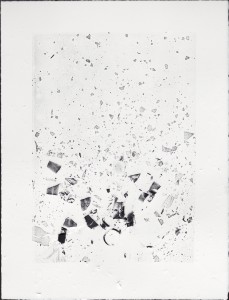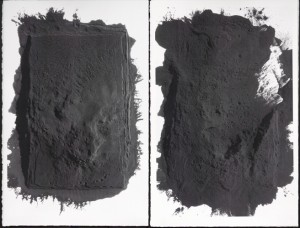 Paulette Rosen, an instructor from the Creative Arts Workshop in New Haven, held a workshop in the Watkinson on making a book by hand. A small but enthusiastic group learned how to assemble and sew a pamphlet and make an accordion-fold book. We learned about the properties of paper, tricks for measuring and folding, sewing, and covering boards. We all came away inspired with ideas for new projects and gifts for the upcoming holidays under the capable guidance of book artist Rosen.
Paulette Rosen, an instructor from the Creative Arts Workshop in New Haven, held a workshop in the Watkinson on making a book by hand. A small but enthusiastic group learned how to assemble and sew a pamphlet and make an accordion-fold book. We learned about the properties of paper, tricks for measuring and folding, sewing, and covering boards. We all came away inspired with ideas for new projects and gifts for the upcoming holidays under the capable guidance of book artist Rosen.



Comments Off on Making books!
 On October 9 book artist Daniel Kelm gave a talk in the library on his life and work. Kelm has a background in chemistry and weaves science into his inventive book structures. He has been commissioned by artists who explore bookish forms to help engineer their non-traditional structures, and he also makes books of his own design that challenge the reader to interact with the books as mechanisms and puzzles. Members of the varied audience–from the chemistry department, Wesleyan University and other parts of Connecticut–had great fun figuring out how the books worked after Daniel’s talk.
On October 9 book artist Daniel Kelm gave a talk in the library on his life and work. Kelm has a background in chemistry and weaves science into his inventive book structures. He has been commissioned by artists who explore bookish forms to help engineer their non-traditional structures, and he also makes books of his own design that challenge the reader to interact with the books as mechanisms and puzzles. Members of the varied audience–from the chemistry department, Wesleyan University and other parts of Connecticut–had great fun figuring out how the books worked after Daniel’s talk.

Comments Off on Daniel Kelm visits!
[Posted by Sally Dickinson, Associate Curator]
 The Watkinson purchased several intriguing pieces from two British book artists this year. Rick Myers visited the library late in 2011 to show some of his amazing art which centers around innovative printmaking techniques with strong associations to historical artifacts and interactions with paper. Before and After Breath (2009) is a series of 5 prints from an edition of 37 housed in a thin plywood box. The prints are the result of a forceful interaction between a pre-1908 carbon filament light bulb and a 50 ton industrial tooling press used to crush the bulb between sheets of carbon paper. The glass shards, which punctured the paper, and the carbon make successively fainter images with each imprint. Ideas emerge from the event: the release of “breath” after over 100 years of being contained in a bulb, the symbolic use of carbon paper as media since carbon is one of the basic elements of life. Myers focuses on process and the use of found materials as much as the end result. Another recent Myers acquisition is a series of 8 prints entitled Itself , described as a “removal of carbon black xerographic toner, then re-used for its reproduction.” The edition is limited to the quantity of toner, (36 realized.) The texture of these prints evokes the surface of the moon as much as anything else.
The Watkinson purchased several intriguing pieces from two British book artists this year. Rick Myers visited the library late in 2011 to show some of his amazing art which centers around innovative printmaking techniques with strong associations to historical artifacts and interactions with paper. Before and After Breath (2009) is a series of 5 prints from an edition of 37 housed in a thin plywood box. The prints are the result of a forceful interaction between a pre-1908 carbon filament light bulb and a 50 ton industrial tooling press used to crush the bulb between sheets of carbon paper. The glass shards, which punctured the paper, and the carbon make successively fainter images with each imprint. Ideas emerge from the event: the release of “breath” after over 100 years of being contained in a bulb, the symbolic use of carbon paper as media since carbon is one of the basic elements of life. Myers focuses on process and the use of found materials as much as the end result. Another recent Myers acquisition is a series of 8 prints entitled Itself , described as a “removal of carbon black xerographic toner, then re-used for its reproduction.” The edition is limited to the quantity of toner, (36 realized.) The texture of these prints evokes the surface of the moon as much as anything else.
 A few months later Myers returned to the library with his friend and fellow artist Sam Winston. The synergy between the two was apparent, lightened by a dose of British humor. I spent a stimulating couple of hours listening to Winston explain his intricate work, a blend of visual art and story, with a very high level of craft thrown in. We bought 3 titles: Dictionary Story, Made-Up True Story, and Solace from the Romeo and Juliet series. Winston also gave the library a letterpress print of an illustration he did for the New Yorker, a whirling vortex of letters for a book review called “The English Wars” (May 14, 2012)
A few months later Myers returned to the library with his friend and fellow artist Sam Winston. The synergy between the two was apparent, lightened by a dose of British humor. I spent a stimulating couple of hours listening to Winston explain his intricate work, a blend of visual art and story, with a very high level of craft thrown in. We bought 3 titles: Dictionary Story, Made-Up True Story, and Solace from the Romeo and Juliet series. Winston also gave the library a letterpress print of an illustration he did for the New Yorker, a whirling vortex of letters for a book review called “The English Wars” (May 14, 2012)
 Dictionary Story, written and designed by Winston, is in the form of an accordion book. “From order to chaos and back to order … Dictionary Story graphically illustrates the balance between a world that’s safe but boring and a high risk universe full of creative possibilities.” The graphics of the typography help explain what is happening in the story. The story runs in one column against the outer edge of the page and the definitions opposite their words in another column on the reverse side. As the characters get out of hand, so does the graphic layout as letters tumble over the pages. Made-Up True Story based on the interaction of different kinds of literature from train schedules to fairy tales is another typographic adventure with a charming story built in. Winston augments the effect with a fury of penciled scribbling. In the Romeo and Juliet series he explores the text of a classic work in an analytical dissection, cutting apart the letters and arranging them into 3 emotional states: passion, rage and solace.
Dictionary Story, written and designed by Winston, is in the form of an accordion book. “From order to chaos and back to order … Dictionary Story graphically illustrates the balance between a world that’s safe but boring and a high risk universe full of creative possibilities.” The graphics of the typography help explain what is happening in the story. The story runs in one column against the outer edge of the page and the definitions opposite their words in another column on the reverse side. As the characters get out of hand, so does the graphic layout as letters tumble over the pages. Made-Up True Story based on the interaction of different kinds of literature from train schedules to fairy tales is another typographic adventure with a charming story built in. Winston augments the effect with a fury of penciled scribbling. In the Romeo and Juliet series he explores the text of a classic work in an analytical dissection, cutting apart the letters and arranging them into 3 emotional states: passion, rage and solace.
Both Myers’ and Winston’s paper art is in major collections in the U.S. and abroad, including the British Library, the Victoria and Albert Museum, and the Library of Congress.
Comments Off on Artful bookish things
 On October 9 book artist Daniel Kelm gave a talk in the library on his life and work. Kelm has a background in chemistry and weaves science into his inventive book structures. He has been commissioned by artists who explore bookish forms to help engineer their non-traditional structures, and he also makes books of his own design that challenge the reader to interact with the books as mechanisms and puzzles. Members of the varied audience–from the chemistry department, Wesleyan University and other parts of Connecticut–had great fun figuring out how the books worked after Daniel’s talk.
On October 9 book artist Daniel Kelm gave a talk in the library on his life and work. Kelm has a background in chemistry and weaves science into his inventive book structures. He has been commissioned by artists who explore bookish forms to help engineer their non-traditional structures, and he also makes books of his own design that challenge the reader to interact with the books as mechanisms and puzzles. Members of the varied audience–from the chemistry department, Wesleyan University and other parts of Connecticut–had great fun figuring out how the books worked after Daniel’s talk.






